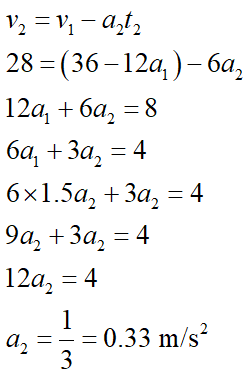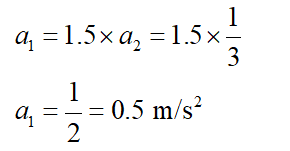The citizen leaves a city at 3:00 p.m. It travels at 36.0 m / s when the engine of its car stops. During the next twelve seconds, the car slows down and its average acceleration is a1. Over the next six seconds, the car slows down even further, and its average acceleration is a2. The speed of the car is 28.0 m / s. The ratio of the average acceleration values is a1 / a2 = 1.50. (a) Find the speed of the car at the end of the initial twelve second interval. (b) Calculate the total distance traveled by the car before stopping.
Displacement, Velocity and Acceleration
In classical mechanics, kinematics deals with the motion of a particle. It deals only with the position, velocity, acceleration, and displacement of a particle. It has no concern about the source of motion.
Linear Displacement
The term "displacement" refers to when something shifts away from its original "location," and "linear" refers to a straight line. As a result, “Linear Displacement” can be described as the movement of an object in a straight line along a single axis, for example, from side to side or up and down. Non-contact sensors such as LVDTs and other linear location sensors can calculate linear displacement. Non-contact sensors such as LVDTs and other linear location sensors can calculate linear displacement. Linear displacement is usually measured in millimeters or inches and may be positive or negative.
The citizen leaves a city at 3:00 p.m. It travels at 36.0 m / s when the engine of its car stops. During the next twelve seconds, the car slows down and its average acceleration is a1. Over the next six seconds, the car slows down even further, and its average acceleration is a2. The speed of the car is 28.0 m / s. The ratio of the average acceleration values is a1 / a2 = 1.50.
(a) Find the speed of the car at the end of the initial twelve second interval.
(b) Calculate the total distance traveled by the car before stopping.
Given:
Initial speed of car (u) = 36.0 m/s
During first t1 =12 seconds the acceleration of car = a1.
During second t2 = 6 s. the acceleration of car = a2.
Ratio of acceleration a1/a2 = 1.5
Part a)
Let the final velocity of car after 12.0 s. = v1.
The kinematic equation for first 12.0 s.,

For the next movement of 6 s. section, the initial velocity will be v1,
The final velocity of car (v2) = 28 m/s.

So the acceleration a1 will be,

Step by step
Solved in 8 steps with 7 images









